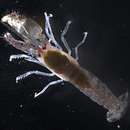Comprehensive Description
provided by Smithsonian Contributions to Zoology
Alpheus collumianus Stimpson, 1860
Alpheus collumianus Stimpson, 1860:30 [type locality: Bonin Islands; in coral in 2 meters].—D.M. and A.H. Banner, 1982:45, fig. 9.
Alpeus Malhaensis Coutière, 1908:205 [type locality: the original pair of specimens came from 2 localities in the western Indian Ocean: Saya de Malha Bank (53 m) and Amirante Isles, Seychelles (53 m)].
Alpheus collumianus probabilis A.H. Banner, 1956:338, fig. 10 [type locality: off northwest coast of Saipan, Mariana Islands; about 3 meters].
Alpheus collumianus medius A.H. Banner, 1956:340, fig. 11 [type locality: Hawaii].
Alpheus collumianus inermis A.H. Banner, 1956:342, fig. 12 [type locality: off Saipan, Mariana Islands; about 6 meters].
DIAGNOSIS.—(Macrocheles Group). Body not unusually compressed or setose; rostrum acute, not nearly reaching as far as distal margin of 1st antennular segment, bluntly but strongly carinate in midline, carina not extending posteriorly far beyond eyes, base not abruptly delimited from adrostral furrows; carapace without median tooth or tubercle on gastric region, without paired large acute teeth overhanging posterior ends of adrostral furrows, anterior margin somewhat convex and unarmed mesial to orbital hoods, typically notched adjacent to rostrum, and region often flattened, orbital hoods varying from armed with strong marginal tooth to unarmed, adrostral furrows deep; 2nd antennular segment 2 to 3 times as long as wide; basal antennal segment (basicerite) varying from unarmed to armed with strong, acute tooth overreaching stylocerite; antennal scale with lateral margin concave, distolateral spine strong, far overreaching narrow blade, but not unusually stout; 1st pereopods with merus armed with few short spines and acute distal tooth on inferior flexor margin; major chela somewhat compressed, about 2 times as long as wide, dactyl nearly straight in longitudinal plane but directed somewhat toward flexor side of chela, not double-ended, bearing short, truncated plunger, palm with strong, carinate tooth on mesial side of articulation interrupted by transverse incision, without longitudinal carina near margin proximal to fixed finger, without “saddle” or distal sinus on palm proximal to adhesive plaque, with indistinct shoulder on margin proximal to fixed finger; minor chela about 3 times as long as wide, fingers about as long as palm, dactyl carinate on extensor margin but not “balaeniceps,” palm with strong tooth on mesial aspect at dactylar articulation, with transverse incision in carina supporting tooth; 2nd pereopod with proximal carpal article distinctly longer than 2nd; 3rd pereopod with dactyl variably biunguiculate, propodus bearing 6 pairs of spines on flexor margin, merus varying from being armed with series of spines and strong distal tooth on flexor margin to complete absence of spines and rounded distal angle, ischium bearing movable spine; maximum carapace length to base of rostrum about 9 mm.
RANGE.—Red Sea, Madagascar, and South Africa to Japan and Australia and Pacific islands to Hawaii and Societies; intertidal reef flats to about 75 meters.
- bibliographic citation
- Chace, Fenner Albert, Jr. 1997. "The Caridean shrimps (Crustacea:Decapoda) of the Albatross Philippine Expedition, 1907-1910, Part 7: Families Atyidae, Eugonatonotidae, Rhynchocinetidae, Bathypalaemonidae, Processidae, and Hippolytidae." Smithsonian Contributions to Zoology. 1-106. https://doi.org/10.5479/si.00810282.381.1

